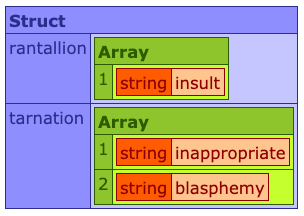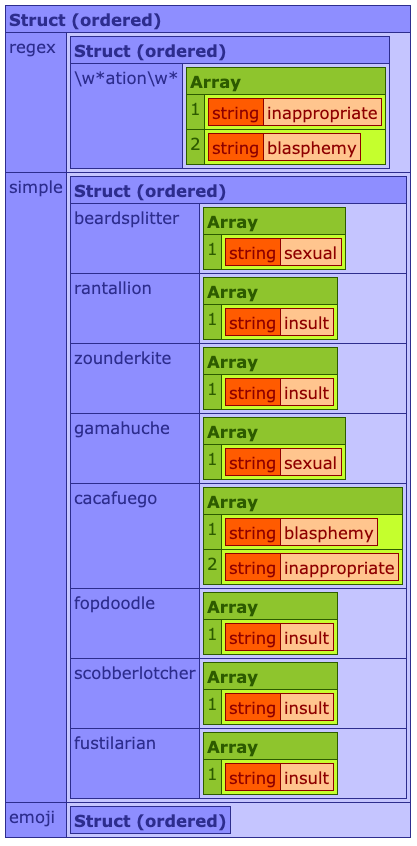Yesterday I was working on a client project that needed some form of curse / explicit word detection within content. This was easy enough (and fun to build), but during my investigations into how others have done similar things, I found a JavaScript package called swearjar-node. The more I looked at it, the more I realised this would be great to convert into a CFML component that could be used server-side for profanity detection.
So last night, whilst listening to and half-watching the fabulous Modernize or Die® Podcast, I created a CFML version of the library.
Introducing the swearjar
Instantiation of the component is simple:
swearjar = new swearjar();
By default the component loads in the en_US.json ‘libary’ file that is included in the config directory which includes a number of horrendous words and their associated categories. This, too, was a direct port of the same config file from the original JavaScript package, and as a result anything you read in there was not included by me. Just to get that caveat out there in case people start thinking “Wow, monkeh has a potty mouth!”.
There are benefits of having a library loaded in such a way, including:
you can add to it when you discover more filth that you want to detect and censor in your application
you can create locale-based versions for your users
Now, in all examples from this point on I will not be using the default library to save blushes and to refrain from having certain words on this blog post. Instead I will be loading in an alternate curse word library created especially for testing purposes: vintage.json.
Yes! Bring on the 17th century filth!
You have two options to load in a different library file:
as part of the init constructor:
swearjar = new swearjar( './config/vintage.json' );
or after instantiating the component using the loadBadWords method:
swearjar.loadBadWords( './config/vintage.json' );
The file is read by the component and the contents are stored in the badWords property, which is publicly-accessible so that you can access it:
stuBadWords = swearjar.getBadWords();

I’ll give you a minute to soak those beauties into your vocabulary.
All done?
Let’s move on then.
You can see that the structure of the library files dictates that you have keys for ‘regex’ values, simple word lookups and also emoji detection.
Detection
To detect profanity in any content, simply pass the text into the profane method, which will return a boolean value depending on whether or not it contains anything declared within the library file:
swearjar.profane( 'What are you doing?!?' ); // returns false
swearjar.profane( 'What in tarnation are you doing, you rantallion?!?' ); // returns true
You can get a detailed structure of profanity using the detailedProfane method:
stuDetailed = swearjar.detailedProfane( 'What in tarnation are you doing, you rantallion?!?' );

Here you can see the response includes the profane boolean value, the words (and the number of times they were included) that it has detected from the library, the categories (and number of items within those categories), and the censored version of the content.
You can directly return the censored string for output using the censored method:
strCensored = swearjar.censor( 'What in tarnation are you doing, you rantallion?!?' );
The result is the original string including the filthy words censored with an asterisk for every character.

Should you wish, you can obtain a struct of all words (and their categories) contained within the passed text using the words method:
stuWords = swearjar.words( 'What in tarnation are you doing, you rantallion?!?' );

The scorecard method analyzes the given text and generates a report of the type of profanity found:
stuScorecard = swearjar.scorecard( 'What in tarnation are you doing, you rantallion?!?' );
This returns a struct containing all categories as keys, with a total count relating to the number of words included in the given text associated with that category:

You may need to programmatically update the curse words you wish to detect and inject them into the component.
You can do this for the simple, regex and emoji values using the addSimple, addRegex and addEmoji methods respectively.
Any new additions you make this way are not written to the file and as such will only be persisted for as long as the component is alive.
Let’s take a quick look at how to add a new simple value to detect.
All you need to do is add the string value to detect, followed by an array of categories that it may be associated with:
wearjar.addSimple( 'fustilarian', [ 'insult' ] );
The addSimple, addRegex and addEmoji methods return void / null, but the value you have provided will have been added to the badWords struct within the component for use:

In the above image you can see we now have fustilarian as a value to check for.
So, that’s the swearjar component. It was a fun quick package to work on, and one that I can see being rather useful. It’s available on Github and Forgebox and is compatible with Lucee 4.5, Lucee 5, ColdFusion 2016 and ColdFusion 2018.
Have at it!

